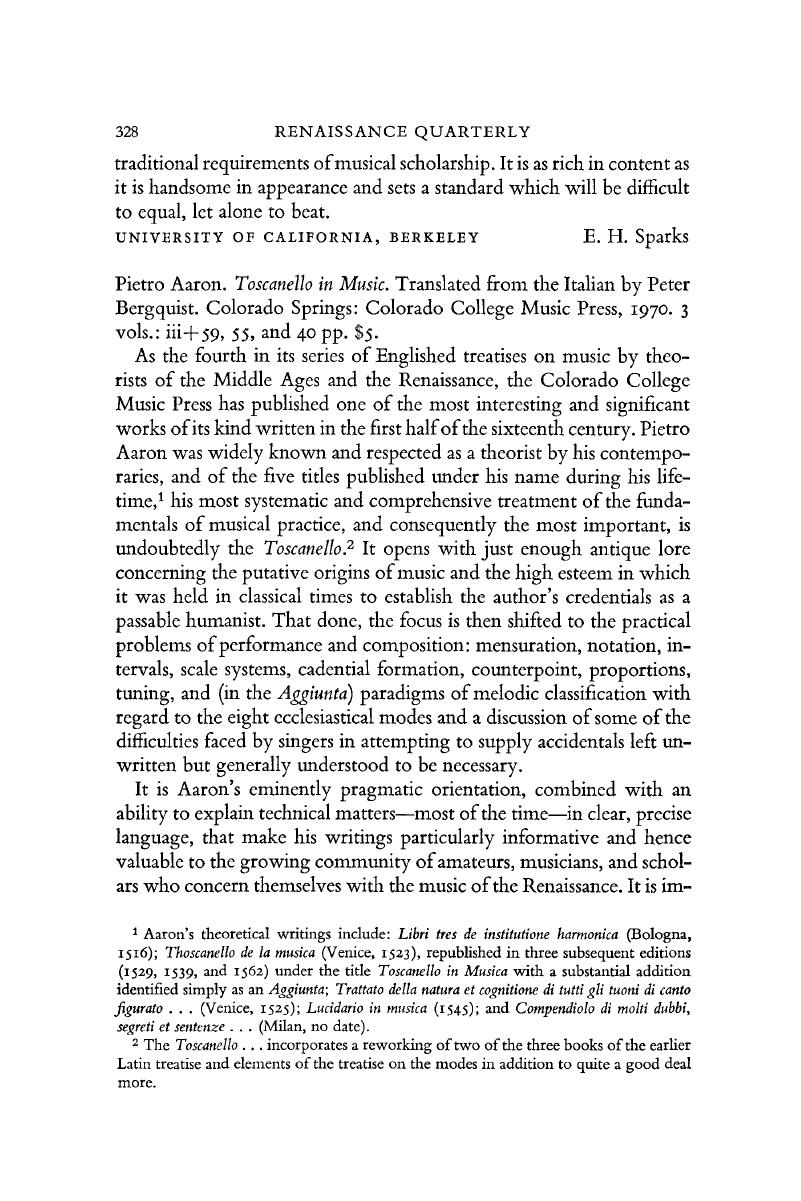No CrossRef data available.
Article contents
Pietro Aaron. Toscanello in Music. Translated from the Italian by Peter Bergquist. Colorado Springs: Colorado College Music Press, 1970. 3 vols.: iii+59, 55, and 40 pp. $5.
Published online by Cambridge University Press: 20 November 2018
Abstract

- Type
- Reviews
- Information
- Copyright
- Copyright © Renaissance Society of America 1972
References
1 Aaron's theoretical writings include: Libri tres de institution harmonica (Bologna, 1516); Thoscanello de la musica (Venice, 1523), republished in three subsequent editions (1529, 1539, and 1562) under the title Toscanello in Musica with a substantial addition identified simply as an Aggiunta; Trattato della natura et cognitione di tutti gli tuoni di canto figurato … (Venice, 1525); Lucidario in musica (1545); and Compendiolo di molti dubbi, segreti et sentenze … (Milan, no date).
2 The Toscanello . . . incorporates a reworking of two of the three books of the earlier Latin treatise and elements of the treatise on the modes in addition to quite a good deal more.
3 The volume is published by Bärenreiter for the Association Internationale des Bibliothèques Musicales and the Internationale Gesellschaft für Musikwissenschaft (Documenta Musicologica, Erste Reihe: Druckschriften-faksimiles) with a Nachwort by Georg Frey. Since the last three editions of the treatise are identical in substance, that of 1539 was selected for reproduction simply because it comprised the fewest number of leaves.
4 ‘Colorado College Music Press Translations, Seay, Albert, editor,’ in the Journal of Music Theory, 12 (Winter, 1968), 281–289.Google Scholar
5 Obviously, all such errors cannot be discussed or even catalogued in a review of the present scope, but the examples cited in the following notes will perhaps serve to illustrate the nature of the problems to be encountered.
6 For example era, the imperfect declension of essere in the third person singular is given as the English noun ‘era’ (1, 5,1. 13, of the translation); prendi, the second person singular imperative form of prendere as ‘I have found’ (1, 7,1. 16); or maschi etfetnine as ‘maskers and women’ (1, 8,1. 30).
7 ‘La musica da la perfettione a tutte le altre sue sorelle dottissime’ ('Music gives perfection to all her other learned sister [arts]’) has been rendered ‘music is the most learned in perfection of all its sister arts’ (1, 10,1. 28); ‘Orpheo … in tanta stima venne, che gli iddii immortali et celesti godevano d'esser celebrati col suo canto, et Bacco sdegnato, che da lui per dimenticanza senza laude fu lasciato, quando ridomando la moglie Eurydice a Plutone, cantava in honore di tutti gli iddii, nel monte Pangeo gli mando contra le sue bacchanti…’ ('Orpheus … came to be so admired that even the immortal, celestial gods were pleased to be celebrated in his song. And Bacchus, angry that he was forgotten and left without praise when [Orpheus], while seeking the return of his wife Eurydice from Pluto, sang in honor of all the gods, sent his bacchantes against him on Mount Pangaeus …’) is given as ‘… when he asked for his wife Eurydice from Pluto. He gained such esteem that the immortal and celestial gods rejoiced to be celebrated in his song; but Bacchus disdained him, for he left him without praises through forgetfulness when he sang in honor of all the gods. On Mount Pangaeus Bacchus sent his bacchantes against him …’ (i, 5,1. 31); unfortunately similar examples are all too numerous.
8 Aaron gives the interval from ‘a’ la mi re to ♮mi acute as a tone and indicates that it falls between mese and trite synetnmenon on the Greek greater perfect system. The latter is actually equivalent to ᒃ fa, however, and the Greek word he should have used is paramese (ni, 6,1.3). Similarly he indicates that the interval from c♯ to eᒃ exceeds the interval of a Pythagorean tone when in reality it consists of two minor semitones in the scale he gives and hence lacks a komma of constituting such a tone (ni, 9, 1. 22).
9 The table on 1, 29, omits ‘mode, perfect’ between ‘imperfect’ and ‘tempus'; on 1, 33, ‘imperfect tempus’ should be ‘perfect’ in both the central and the last column. In addition the example on m, 29, is written a third too high.




